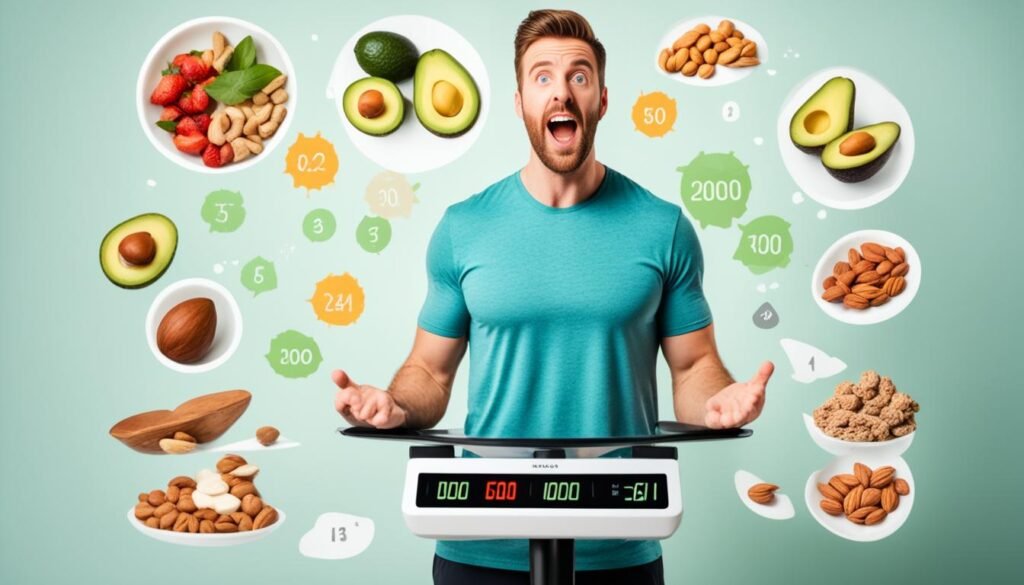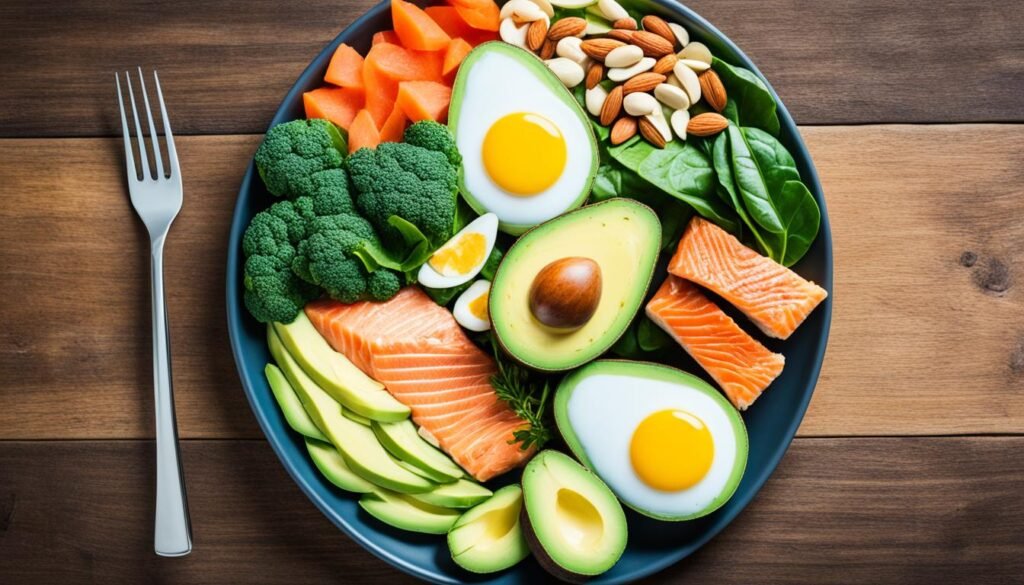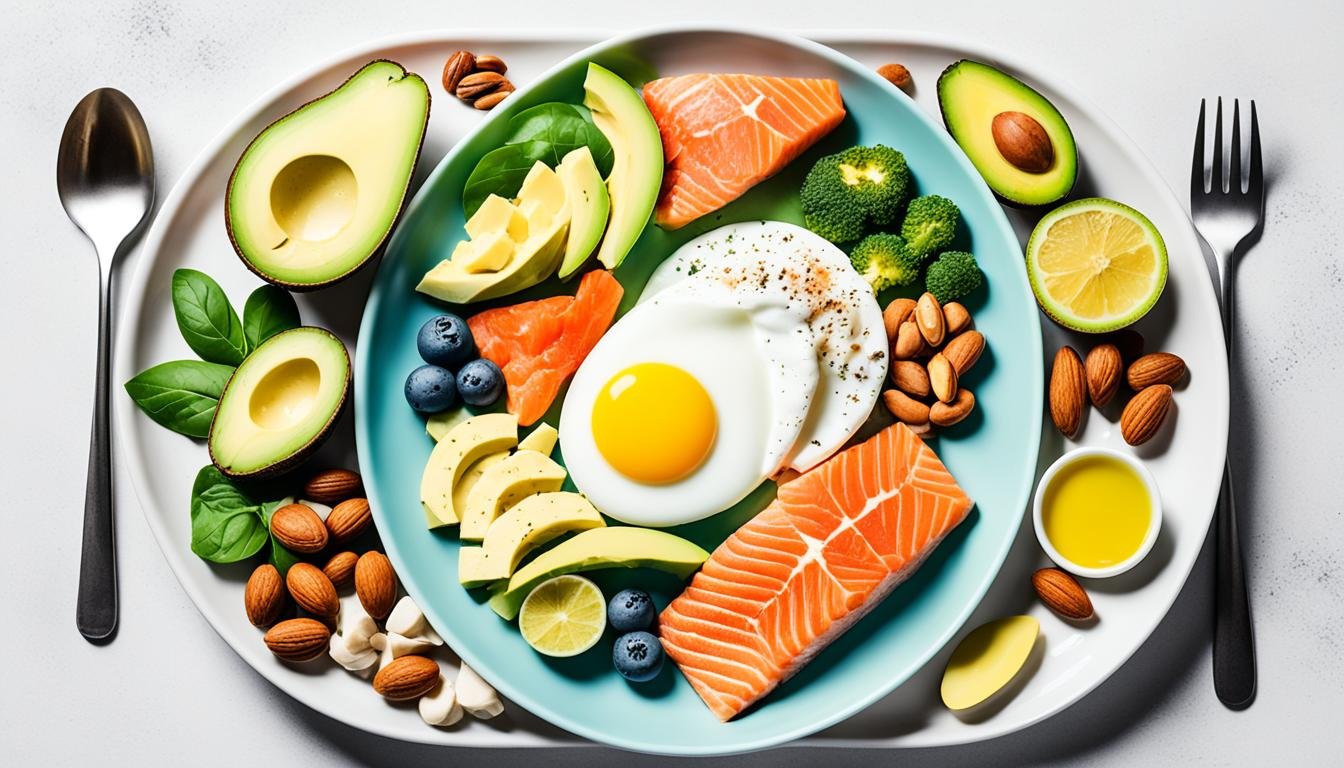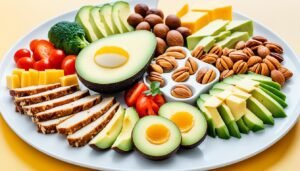The ketogenic diet is a low-carb, high-fat plan. It triggers ketosis, a state where the body uses fat for energy.1 By cutting carbs a lot, it encourages your body to burn fat.
This diet is known for helping lose weight. But back in the 1920s, it was created for epilepsy treatment. Science also says it might help with diabetes, heart disease, cancer, and brain-related problems.
Key Takeaways
- The ketogenic diet is a low-carb, high-fat diet that puts the body into a state of ketosis.
- The keto diet was originally developed to treat epilepsy, but it has since gained popularity for weight loss and other health benefits.
- The standard ketogenic diet (SKD) typically contains 70% fat, 20% protein, and only 10% carbs.1
- Following a ketogenic diet can lead to slightly more long-term weight loss compared to a low-fat diet.1
- The keto diet may have benefits for conditions like diabetes, heart disease, and neurological disorders.
Keto Diet Basics
The ketogenic diet is all about eating fewer carbs and more fats. It’s similar to Atkins and other low-carb diets. You cut carbs a lot and eat more fat.1 On the keto diet, you get about 70% of your calories from fat. Protein makes up around 20%, and carbs are just 10%.1
What is the Ketogenic Diet
When you eat very few carbs, your body goes into ketosis. This is when it starts burning fat instead of carbs.2 Your liver turns fat into ketones. These ketones help power your brain. This change can lower your blood sugar and insulin, which is good for your health.1
How the Keto Diet Works
Doctors have used ketogenic diets to help control seizures for a long time, even since the 1920s.2 To get into ketosis, you usually need to eat under 50 grams of carbs a day. After a few days, your body is in full ketosis.2
Benefits of the Keto Diet
Studies have found many good things about the keto diet. It can help with losing weight and improving how your body handles insulin. This diet also lowers some risks of heart disease. Plus, it might help with conditions like Alzheimer’s, Parkinson’s, and epilepsy.1 There’s also talk it could fight against some cancers and help people with PCOS and brain injuries.1,3,2
Keto Diet Food List
What to Eat on Keto
The keto diet focuses on foods high in fat and moderate in protein. It cuts down on carbs. Good choices are meats, fish, eggs, and dairy. Nuts, seeds, and certain veggies are also great. You can use healthy oils, too.456
Foods to Avoid on Keto
To stay in ketosis, you’ll steer clear of carb-heavy items. This means no sugary treats, grains, or most fruits. Also, say no to beans, some veggies, and starchy foods. Processed items, low-fat products, and certain sauces should be off your plate. Oh, and alcohol doesn’t fit the plan either.56

Achieving Ketosis
Ketosis is a state where the body turns to fat for energy, not carbs. It happens when you eat fewer carbs, which cuts off the main energy source, glucose. To stay in ketosis, most people follow a diet that’s low in carbs, keeping their daily intake between 20 and 50 grams.7
What is Ketosis?
In ketosis, your body uses fat as its main source of energy. When you don’t eat many carbs, your body starts breaking down fat. The liver then turns this fat into ketones, which fuel the body and even the brain.7
Signs of Ketosis
If you’re in ketosis, you might notice you’re often thirsty with a dry mouth. You could be urinating more than usual and feel less hungry. Testing your blood, urine, or breath for ketones can confirm if you’re in ketosis.8
| Indicator | Typical Range |
|---|---|
| Blood Ketones | 1.5–3.0 mmol/L7 |
| Urine Ketones | Moderate to large |
| Breath Ketones | Detectable |
To get into ketosis, most people need to cut their carb intake. They aim for about 20-50 grams of carbs a day. How many carbs you can eat and still get into ketosis depends on things like how active you are and your general health.9
Keto for Weight Loss
Studies say the ketogenic diet is good for losing weight. This diet is high in fat and low in carbs. It helps burn fat and lower blood sugar. It is also filling, which makes you eat less without counting calories.1
How Keto Aids Weight Loss
The keto diet works for weight loss. But it’s not just about eating fewer calories. It changes how your body uses energy by burning fat.1 Research shows its weight loss benefits are similar to low-fat diets, even if you don’t watch every calorie.10
Keto and Calorie Restriction
This diet makes your body burn fat and eat fewer calories naturally.1 The change in how your metabolism works, along with the diet, helps you lose weight.1


Keto and Diabetes
The ketogenic diet helps a lot with type 2 diabetes or prediabetes. Studies show it boosts insulin sensitivity and lowers blood sugar. It can even reverse type 2 diabetes in some cases.11 The keto diet’s weight loss and fat-burning features can also manage the condition.11 Yet, those with diabetes must talk to their doctors before trying the keto diet. This is because medication might need to be adjusted.
| Study | Findings |
|---|---|
| 2012 study on low-calorie versus low-carbohydrate ketogenic diet in type 2 diabetes | Showed an effect on Nutrition12 |
| 2018 study on overweight and diabetes prevention | Indicated a pivotal role for low-carbohydrate–high-fat diets12 |
| 2018 study on fat versus carbohydrate-based energy-restricted diets | Showcased varied impacts on weight loss in patients with type 2 diabetes12 |
| 2013 research on the therapeutic uses of very-low-carbohydrate (ketogenic) diets | Focused on uses beyond weight loss12 |
| 2008 study on the ketogenic diet for the treatment of childhood epilepsy | Conducted a randomized controlled trial12 |
| 2014 study on long-term ketogenic diet in mice | Caused glucose intolerance and reduced β- and α-cell mass without weight loss12 |
| 2016 meta-analysis of randomized controlled trials | Compared low-carbohydrate diets with low-fat diets on body weight and cardiovascular risk factors12 |
| 2018 DIETFITS randomized clinical trial | Evaluated the effects of low-fat versus low-carbohydrate diet on weight loss in overweight adults12 |
| 2018 trial on low carbohydrate diet and energy expenditure | Assessed the impact on weight loss maintenance12 |
These studies look at how keto and low-carb diets affect people with type 2 diabetes. They suggest these diets can lead to weight loss and better control of blood sugar. The findings show promising health benefits from these eating plans.
What is the Ketogenic Diet for Other Health Conditions?
The ketogenic diet was first a therapy for epilepsy. It has been impressive in cutting down seizures in kids.2 Besides epilepsy, it might also help with other brain conditions like Alzheimer’s and Parkinson’s. We’re not completely sure why, but it could be because of how ketones protect the brain and enhance cell energy.
Keto for Neurological Conditions
Since the 1920s, the keto diet has helped control seizures for people with certain health issues.2 More than half of people with epilepsy might see less severe seizures on it.13 A version called the modified Atkins diet could help adults and most kids over two with their seizures too.13
Scientists are also looking into how it might help diseases like Alzheimer’s and Parkinson’s. They think it might protect the brain and make cell energy better.
Keto for Cancer
Some studies have looked into using the keto diet to support cancer treatment. The idea is to starve cancer cells of their main food, glucose, by cutting carbs.13 Tests on mice have shown this could slow down some cancer types. It also might help keep muscle and limit tumor growth.13 Yet, there’s not enough research on how well it works for cancer in humans. More studies are needed to find out if and how the keto diet could help fight cancer.
Keto for Heart Disease
How the keto diet affects heart health is still debated. Some studies say it might lower the risk of issues like obesity, high blood pressure, and diabetes.2 But other research is concerned it could harm the heart in the long run.2 We need more research to know how the keto diet truly affects heart health over time.


Types of Ketogenic Diets
The ketogenic diet comes in different forms, each with unique benefits. Here’s a look at the various types:
Standard Keto Diet
The standard ketogenic diet is the most known. It involves eating very few carbs (about 10% of total calories), a moderate amount of protein (20% of calories), and mostly fats (70% of calories).114
Cyclical Keto Diet
The cyclical ketogenic diet alternates between low-carb periods and higher carb intakes. For example, someone might do strict keto for 5 days and then eat more carbs for 2 days. Athletes and bodybuilders often use this to maintain their energy levels.1
Targeted Keto Diet
The targeted ketogenic diet involves adding carbs around your exercise routine. The goal is to boost muscle performance with extra glucose without leaving the state of ketosis.1
High-Protein Keto Diet
This version of the keto diet includes more protein, about 35% of your daily calories. You’d get 60% of your calories from fat and only 5% from carbs.114
Getting Started on Keto
Starting the keto diet means choosing high-fat, moderate-protein, and low-carb foods. Go for meat, fish, eggs, dairy, nuts, seeds, oils, and veggies.1 Make meal and snack plans to keep your macros right and stay in ketosis.1
Keto Diet Meal Plan
The keto diet is about 70% fat, 20% protein, and only 10% carbs. Focus on foods like fatty meats, fish, eggs, butter, cheese, nuts, and avocados.1 Cut back on grains, fruits, and starchy veggies to reach this balance.
Keto-Friendly Snacks
For snacks, choose options with good fats, decent protein, and few carbs. This helps battle hunger and keep in ketosis.15 Good choices are nuts, seeds, nut butter, coconut yogurt, eggs, fish, cheese, and veggies like celery and peppers.15


Potential Side Effects
Keto Flu
Starting the keto diet can bring on the “keto flu.” It’s a set of symptoms your body shows while getting used to using fat instead of carbs. You might feel bad with headaches, fatigue, nausea, and more.16 These are usually short-lived and can be lessened by drinking water, taking electrolytes, and easing into the diet.
Other Side Effects
There are more than the keto flu to watch out for on the keto diet. You could face constipation,1716 lacking certain nutrients,16 kidney stones, and a rise in bad cholesterol for some.16 Keep an eye on your health and talk to a doctor if needed, especially with health issues.
Tips for Keto Success
To do well on the ketogenic diet, it’s key to plan your meals and drink enough water.18 You should also take electrolyte supplements and ease into the diet. This helps avoid side effects.
The daily carb limits on this diet are quite low. You should aim to eat not more than 35 grams of total carbs and 20 grams of net carbs.18 Stick to keto-friendly foods like meats, certain vegetables, high-fat dairy, and nuts.18 You can also enjoy avocados, berries, healthy sweeteners, and fats. Be sure to skip tubers, most fruits, sugar, and grains.18
Tracking your food intake with apps such as MyFitnessPal and Cronometer works great.18 Using a food scale boosts the accuracy of your portion sizes and calorie counting. But always watch your health and adjust your plan. The keto diet might not fit everyone.19 Most people find slowly cutting out 40-50 grams of carbs each day easy.19 You should aim for around 50 grams of carbs daily to enter ketosis.19
It’s smart to talk to a doctor or a dietitian before trying the keto diet.19 They can make sure you’re doing it right and safely.19 Remember, you should only get about 5% of your daily calories from carbs when on keto. Some might feel unwell at first, which is called the “keto flu.”19 This diet isn’t for kids, pregnant women, elite athletes, or those with type 1 diabetes.19
Conclusion
The ketogenic diet is now a popular way to lose weight and improve health. But, it works well for some people more than others. It’s key to know the good and bad parts ahead of time.10 The diet includes 70-80% from fats, 5-10% from carbs, and 10-20% protein. It also keeps carbs under 50 grams each day, and sometimes even less.10
This diet might help with serious conditions like epilepsy and diabetes. But, we still need more studies to be sure of its long-term effects.20 Research has looked at how the diet affects these issues, and if it’s good for losing weight and staying healthy.20
When thinking about trying the keto diet, talking with a doctor is smart. They can figure out if it matches your health goals.20 The CDC shows that obesity is big trouble. And, a recent report suggests people are still very interested in the ketogenic diet.20
FAQ
What is the ketogenic diet?
How does the keto diet work?
What are the benefits of the keto diet?
What foods can I eat on the keto diet?
What foods should I avoid on the keto diet?
What is ketosis and how do I achieve it?
How can I tell if I’m in ketosis?
How does the keto diet aid weight loss?
Can the keto diet help with type 2 diabetes?
What are the potential benefits of the keto diet for other health conditions?
What are the different types of ketogenic diets?
What should I do when starting the keto diet?
What are some potential side effects of the keto diet?
Source Links
- https://www.healthline.com/nutrition/ketogenic-diet-101
- https://www.webmd.com/diet/ss/slideshow-ketogenic-diet
- https://www.eatingwell.com/article/290697/ketogenic-diet-101-a-beginners-guide/
- https://www.healthline.com/nutrition/ketogenic-diet-foods
- https://www.eatingwell.com/article/291245/complete-keto-diet-food-list-what-you-can-and-cannot-eat-if-youre-on-a-ketogenic-diet/
- https://getkeyto.com/keto-diet/food-list/
- https://www.healthline.com/nutrition/how-long-does-it-take-to-get-into-ketosis
- https://www.medicalnewstoday.com/articles/324599
- https://www.healthline.com/nutrition/7-tips-to-get-into-ketosis
- https://nutritionsource.hsph.harvard.edu/healthy-weight/diet-reviews/ketogenic-diet/
- https://www.healthline.com/health/type-2-diabetes-ketogenic-diet
- https://www.ncbi.nlm.nih.gov/pmc/articles/PMC6566854/
- https://www.healthline.com/nutrition/15-conditions-benefit-ketogenic-diet
- https://www.diabetes.co.uk/keto/types-of-ketogenic-diet.html
- https://www.webmd.com/diet/keto-diet-for-beginners
- https://www.health.com/weight-loss/keto-diet-side-effects
- https://www.healthline.com/nutrition/dangers-of-keto-diet
- https://www.ruled.me/the-10-best-tips-for-keto-diet-success/
- https://www.nutritionnews.abbott/healthy-living/diet-wellness/how-to-start-a-keto-diet–5-tips-for-success/
- https://www.ncbi.nlm.nih.gov/pmc/articles/PMC9312449/




